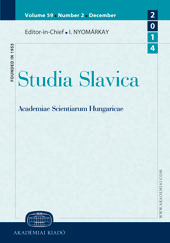Общие элементы языковой картины мира в «русской культурной зоне»
General elements of the language picture of the world in the "Russian cultural zone"
Author(s): Imre PacsaiSubject(s): Cultural history, Customs / Folklore, Theoretical Linguistics, Eastern Slavic Languages, Philology
Published by: Akadémiai Kiadó
Keywords: Russian cultural zone; the Volga basin; cultural and linguistic contacts; comparative research; coordinative compound; Russian folk language; type of derivation;
Summary/Abstract: The linguistic image of the world has been in the focus of linguistic studies in the late 20th century. This problem has close contact with the character of national mentality, which is reflected in the structures of national language. This paper examines the character of Russian folk language, which has specific structures that are not typical for West-Slavic languages. My aim is to make a structural comparison of Russian and West Slavic languages with languages of the East-Euroasiatic area. This comparative research reveals a number of similarities in the vocabulary, phraseology, derivation, and syntax of the languages in the examined territory. The specific element of Russian folk language is the coordinative compound, which is a typical structure of the East-Euroasiatic languages. This type of derivation is not used in West Slavic languages, which is proved by results of our comparative research. The semantic, morphologic, and phonetic parallels between Russian, Finno-Ugric, Turkish, and other Asiatic languages explore the common feature of the linguistic image of the world. This similarity has been formed by cultural and linguistic contacts in the area referred to as the “Russian cultural zone” by N. S. Trubetzkoy.
Journal: Studia Slavica Academiae Scientiarum Hungaricae
- Issue Year: 56/2011
- Issue No: 2
- Page Range: 337-350
- Page Count: 14
- Language: Russian
- Content File-PDF

